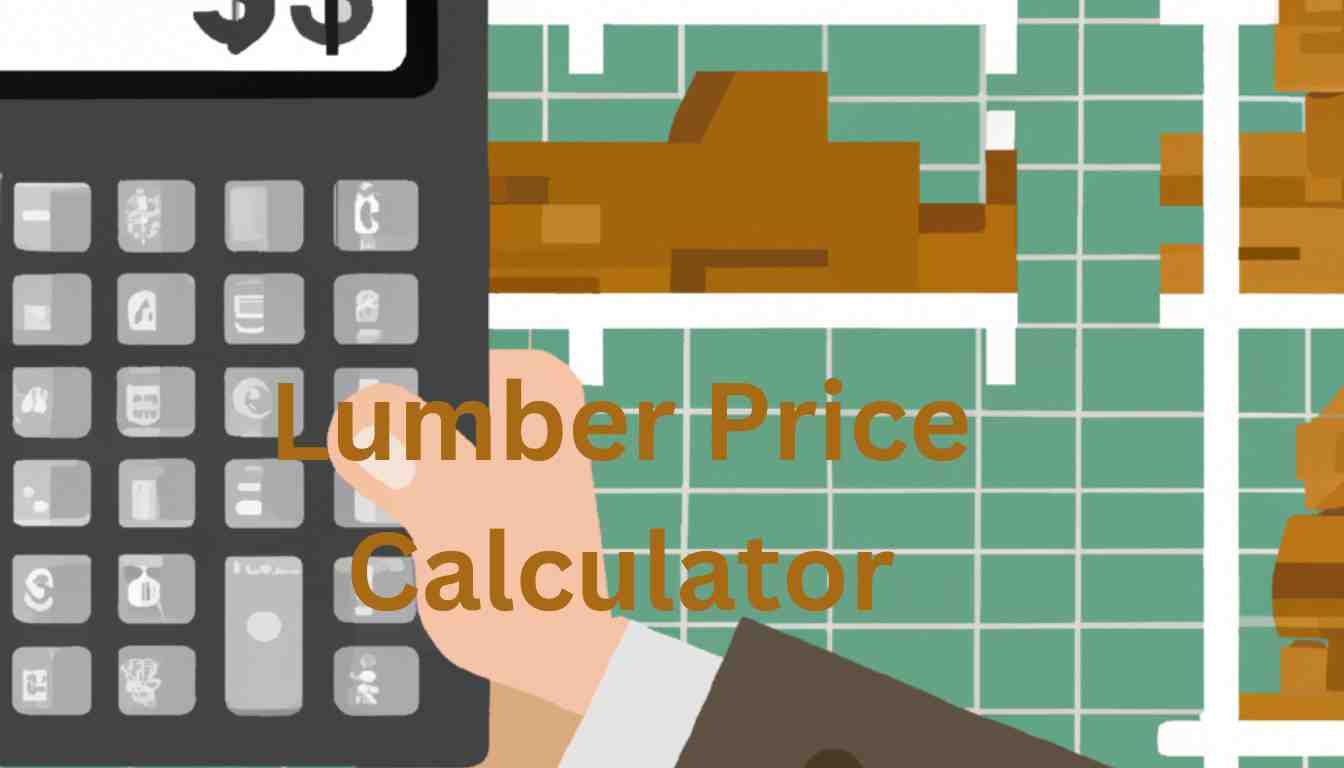A lumber price calculator helps you estimate the cost of lumber for a project. It considers dimensions, wood type, and quantity.
Lumber Cost Estimator Calculator
In the realm of construction and woodworking, one key tool for efficient budgeting is a lumber price calculator. Accurate cost estimation is essential for contractors, DIY enthusiasts, and builders, making this calculator an indispensable asset. By inputting the specifics of your lumber requirements, such as species of wood, dimensions, and total volume, you can quickly receive a calculated cost.
This tool simplifies the planning process, makes budget management more straightforward, and aids in cost comparisons between suppliers. With the construction industry’s dynamics always shifting, having real-time cost estimates can make a substantial difference in managing project expenses and timelines.
The Mechanics Of Lumber Pricing
Understanding lumber pricing is key for both professionals and DIY enthusiasts. Prices fluctuate often. They reflect market conditions, availability, and other vital factors. This guide demystifies how lumber costs are calculated.
Factors Influencing Lumber Costs
Diverse elements affect lumber pricing:
- Supply and Demand: Economic principles play a large role.
- Log Quality: Better logs yield higher-priced lumber.
- Transportation Costs: Longer distances increase prices.
- Processing Techniques: Advanced methods may raise costs.
- Market Trends: Prices vary with housing and construction changes.
Standard Lumber Measurements And Units
Lumber size and volume determine pricing. Here’s a breakdown:
| Measurement | Unit | Description |
|---|---|---|
| Board Foot | BF | Thickness x Width x Length (in inches) / 144 |
| Linear Foot | LF | Length only, regardless of thickness or width |
| Square Foot | SF | Width x Length (in feet) |
| Cubic Foot | CF | Thickness x Width x Length (in feet) |
Most lumber is sold by the Board Foot. It accounts for thickness, making it a fairer measure for pricing.
Digital Tools For Lumber Estimates
Imagine building a project and knowing the exact lumber costs up front. Digital tools for lumber estimates make this a reality. They turn hours of number crunching into minutes of effortless calculation. In the world of construction and DIY projects, these tools are game-changers.
Traditional Calculation Methods Vs. Modern Tools
Throwing back to the old days, estimators used pencils, paper, and calculators. Complex math would often lead to mistakes. Today’s modern tools are more efficient. They reduce errors and save time.
Let’s compare:
| Traditional Methods | Modern Tools |
|---|---|
| Manual calculations | Automatic calculations |
| Time-consuming | Fast and efficient |
| Potential for errors | Improved accuracy |
Top Lumber Price Calculator Apps
The top contenders in the digital tool space stand out for their precision and user-friendly interfaces. Below is a list of apps that lead the market.
- LumberCalc – An app with a clean design that allows custom pricing inputs.
- Woodworkers Calculator – Ideal for carpenters and hobbyists focusing on detailed projects.
- BuildCalc – Offers versatile functions including lumber and material estimates.
Each app tackles lumber costs from unique angles. Some focus on simplicity while others offer complex functions. They all help users save resources and time.
Building Your Lumber Price Calculator
Understanding lumber prices helps you budget accurately for your projects. A lumber price calculator becomes essential. Let’s craft a tool tailored to make cost estimation as straightforward as possible. Consider key features and market variables to enhance calculator utility.
Key Features For User-friendly Calculators
Imagine a calculator that is a joy to use. To achieve this, essential features are non-negotiable. They ensure that users can input data, receive accurate costs, and adjust for different lumber types with ease. Below, find attributes your calculator should possess:
- Intuitive Design: Clear layout, easy navigation.
- Flexibility: Handles various wood types, sizes.
- Real-Time Updates: Prices adjust automatically.
- Unit Conversion: Switch between metric, imperial units.
- Quantity Breakdown: Detailed view of different lumber pieces.
- Save/Export Options: Download quotes for convenience.
Incorporating Market Variables
Market conditions fluctuate, influencing lumber costs. Your calculator must mirror these variations for precise estimations. Here’s how to encapsulate market dynamics:
| Market Variable | Impact on Price | Calculation Method |
|---|---|---|
| Seasonal Changes | Seasons affect lumber supply and price. | Update prices as seasons change. |
| Trade Policies | Tariffs and trade agreements alter costs. | Adapt calculator for new policies. |
| Global Demand | Global need for lumber can raise prices. | Reflect global trends in real-time. |
| Local Availability | Lumber availability varies regionally. | Factor in local supply variables. |
Be vigilant. Adjust regularly to maintain accuracy.

Credit: handtoolessentials.com
Lumber Price Fluctuations
Lumber Price Fluctuations are a significant aspect of the construction and woodworking industries. Just like the stock market, prices for lumber can change quickly. Recent years have seen huge swings in prices. This affects everyone from builders to do-it-yourself enthusiasts. Below, explore how keeping track of market trends and using predictive analysis can help in forecasting these changes.
Tracking Market Trends
Keeping up with current market conditions is critical in understanding lumber price changes. Prices can be influenced by a variety of factors:
- Natural disasters that impact supply chains
- Changes in trade policies
- Supply and demand dynamics
Several tools and platforms offer real-time data on lumber prices. These tools track historical data and current trends. By using them, businesses and individuals can make informed decisions.
Predictive Analysis For Future Pricing
Predictive analysis uses past and current data to forecast future lumber prices. It helps prepare for upcoming shifts:
- Analyze historical price patterns
- Examine market forces
- Employ statistical models for projections
A Lumber Price Calculator often incorporates predictive analytics. This offers a glimpse into potential future costs. Making the right move at the right time could lead to significant savings.
Economic Impact On Lumber Costs
The Economic Impact on Lumber Costs involves various factors such as market trends, trade deals, and resource availability. Understanding these impacts can help predict and navigate fluctuations in lumber expenses.
Influence Of Trade Policies
Trade policies greatly affect lumber prices. They shape the flow of wood between countries. When a country imposes tariffs, lumber can become expensive. This is because tariffs are extra costs added to the imported wood. Trade agreements can also lower costs if countries decide on fewer taxes.
- Import restrictions lead to scarcity and higher prices.
- Trade deals that encourage exports can reduce domestic supply and push up expenses.
Natural Disasters And Resource Availability
Natural disasters impact lumber supply, affecting costs. Forest fires, storms, or pests can destroy trees. This means there are fewer trees to make lumber. Fewer trees lead to higher prices.
| Disaster Type | Impact on Lumber Supply |
|---|---|
| Forest Fires | Destroy lumber sources, causing immediate supply drops. |
| Storms | Can halt lumber production and transport, delaying supply. |
| Pests | Infect trees, reducing lumber quality and quantity. |
In conclusion, prices fluctuate based on how much wood is available. If trees are abundant and healthy, lumber is usually less expensive. When trees are scarce, costs rise.

Credit: www.garagewoodworks.com
Frequently Asked Questions Of Lumber Price Calculator
How Do You Calculate Lumber Prices?
To calculate lumber prices, multiply the lumber’s price per board foot by the total number of board feet you need. Keep in mind, prices vary by wood type, quality, and region. Always check current market rates for the most accurate pricing.
How Do I Calculate My Lumber?
To calculate lumber, measure the length, width, and thickness in inches. Multiply these dimensions and then divide by 144 to convert to board feet. Consider waste by adding 10-15% for cuts.
How Much Is A Board Foot Of Lumber Worth?
The price of a board foot of lumber varies, typically ranging from $1 to $5 based on type, quality, and market conditions.
How Do You Calculate Total Cost Of Wood?
Calculate the total cost of wood by multiplying its price per unit (such as per board foot or cubic foot) by the quantity needed. Include any additional expenses like delivery or cutting fees for the final amount.
Conclusion
Navigating lumber costs need not be a daunting task. Our Lumber Price Calculator simplifies budgeting for your project with precision. Embrace the ease of planning and bid farewell to uncertainty. Let this tool guide your next woodworking venture to success and efficiency.
Start calculating now to make informed financial decisions.


